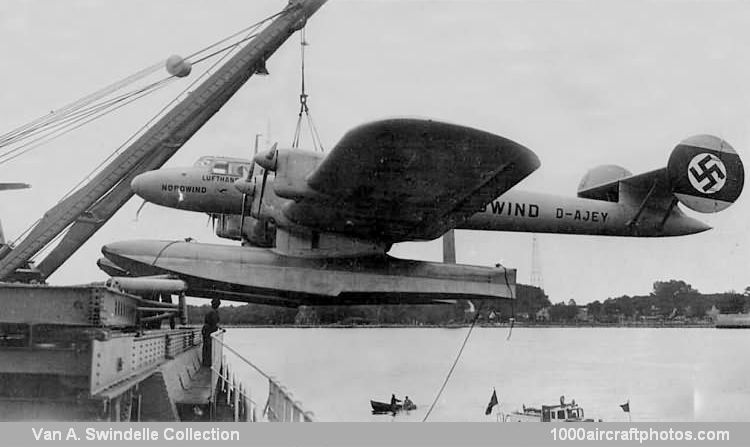08/15/2008. Remarks by Johan Visschedijk: "In 1935 Lufthansa issued a specification for a long-range seaplane that could be launched by catapult from German depot ship, but capable also of taking off from and landing on rough water; to this specification Dr.Ing. Richard Vogt designed the Ha 139. The first prototype Ha 139 V1, D-AMIE c/n 181 "Nordmeer" (North Sea), flew for the first time in October 1936, followed shortly thereafter by the Ha 139 V2 "Nordwind" (North Wind), and both aircraft were delivered to Lufthansa in the following March, designated Ha 139 A by the airline.
Between August 15 and late November both aircraft made a total of seven return crossings of the North Atlantic, operating from the MSS "Schwalbenland" off the Azores and "Friesenland" off Long Island. With a crew of four, 1,058 lb (480 kg) of mail was carried. During the winter replacing the radiators from the float stubs to the wings solved cooling problems with the four 600 hp Junkers Jumo 205C six-cylinder double-opposed liquid-cooled diesel engines. Also the poor directional stability was countered by increasing and altering the shape of the rudders.
The third prototype Ha 139 V3, D-ASTA c/n 217 "Nordstern" (North Star), was finished in early 1938, this being of somewhat larger overall and had several other refinements. When delivered to Lufthansa it was designated Ha 139 B. All three aircraft were used for Atlantic crossings and by June 1939, forty crossings had been made over the North Atlantic and 60 over the South Atlantic (between Bathurst, Gambia and Natal or Recife, Brazil).
Upon the outbreak of WW II the three aircraft and their crews were impressed into the Luftwaffe. The third aircraft was converted for the reconnaissance role and fitted with an external structure for de-gauzing magnetic mines. It was redesignated Ha 139 V3/U1 and flown for the first time on January 19, 1940. All three aircraft were used in the Norwegian campaign, however shortage of spares limited their service and they were subsequently scrapped."
